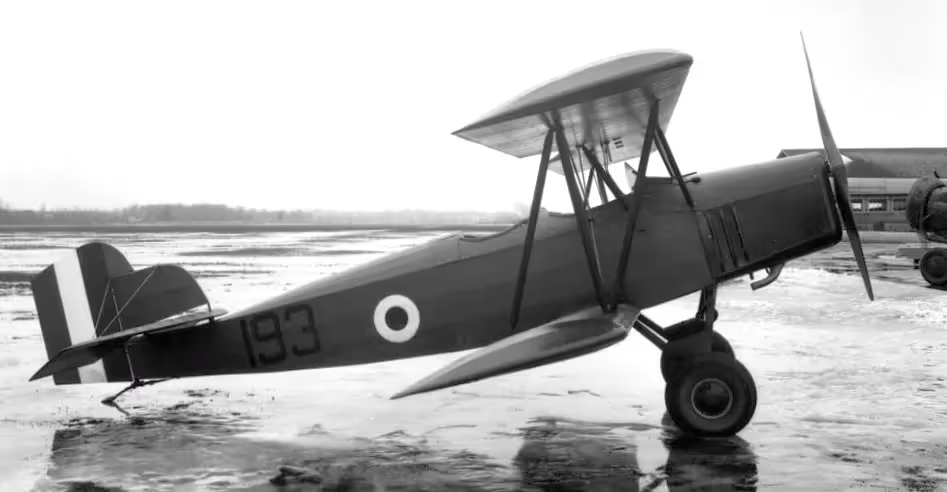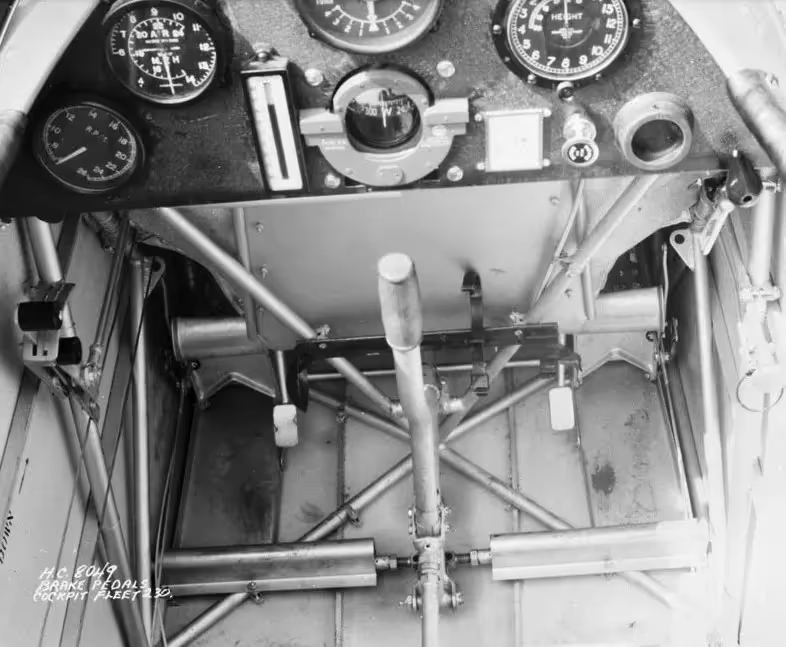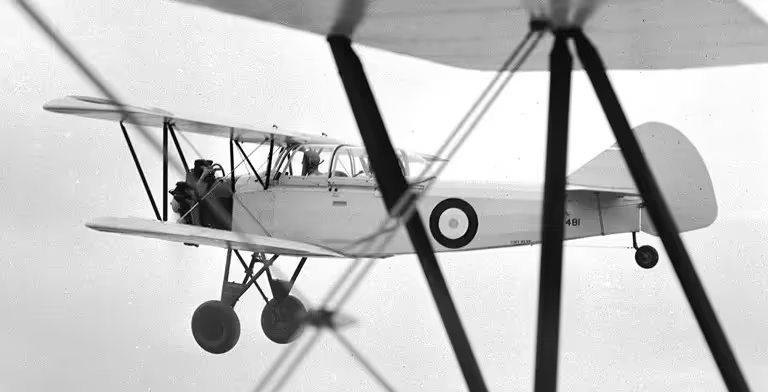Canadian Warplanes 2: Fleet Fawn and Fleet Finch trainers
Fleet Fawn and Fleet Finch trainers

(RCAF Photo)
Fleet Fawn Mk. II , RCAF (Serial No. 219).
Fleet Fawn Mk. I (20), (biplane), (Serial Nos. 190-209), Model 7C Fawn Mk. II (31), (Serial Nos. 213-222, 228-237, 259-265, 280-283), for a total of 51 aircraft.
In the 1930s, Fleet Aircraft built a series of single-engined, two-seat biplane training aircraft. The Fleet Fawn Mk. I (Model 7B) and Fawn II (Model 7C) were purchased by the RCAF as primary trainers. After years of reliable service, many were used by pilots training with the British Commonwealth Air Training Plan (BCATP) during the Second World War. Many Fawns were produced in the Canadian plant at Fort Erie, Ontario.
A variety of equipment could be fitted to the Canadian variant including optional wheel brakes, a tail skid or tail wheel arrangement, a fuselage belly tank and a fixed cockpit enclosure or "coupe top" with hinged sides. During the late 1930s, a sliding cockpit enclosure became standard equipment of all RCAF Fawns. The aircraft could also be configured to use skis, floats or wheels. The main landing gear's radius rods (the members joining the inner ends of the wheel axles to each opposing corner of the fuselage) on the Models 2 and 7 were notable for having the one coming from the left wheel "looped", with an open oval piece near its middle, so the one from the right mainwheel could pass right through it.
Engine choices further dictated the different variants of the Fawn design: the Mk. I (Fleet Model 7B) with a 125 hp (93 kW) Kinner B-5 engine was superseded by the Mk. II (Fleet Model 7C) powered by a 140 hp (100 kW) Armstrong Siddeley Civet seven-cylinder radial engine. Although the RCAF ordered the bulk of the production runs, 12 civil-registered Model 7Bs were completed for the Department of National Defence to be issued to flying clubs.
The Fleet Model 7 first saw service with the Royal Canadian Air Force in 1931 when 20 Mk. Is were delivered. As a two-seater primary trainer they were felt to have excellent flying characteristics together with a rugged strength which inspired confidence in novice pilots. The RCAF was very impressed with the Fleet Fawn and claimed that the aircraft was one of the factors which improved its flying standards during the 1930s.
A total of 31 Model 7Cs were built between 1931 and 1938 at the Fleet Aircraft of Canada's plant at Fort Erie, Ontario, with the first deliveries made in 1936. Due to the smoother, quieter and more powerful engine, the Model 7C was considered the definitive variant.
Forty three Fleet Model 7B and C trainers were operational with the Royal Canadian Air Force when war was declared in 1939. In service during the Second World War, the RCAF adopted the name "Fawn" for both variants. Along with the more modern follow-up design, the Fleet Finch, Fleet Fawns helped train thousands of pilots under the British Commonwealth Air Training Plan during the war. The Fawn remained in service with the RCAF until 1947. (Wikipedia)
This article is based on the copyrighted Wikipedia article Fleet Fawn, and is used under the GNU Free Documentation License. You may redistribute it, verbatim or modified, providing that you comply with the terms of the GFDL.

(Library and Archives Canada Photo, MIKAN No. 4324994)
Pilot framed by a Harvard as he heads back to the hangar from his Fleet Fawn (Serial No. 295), Halifax, Nova Scotia, 1940.

(Library and Archives Canada Photo, MIKAN No. 3390417)
Fleet Fawn Mk. I, RCAF (Serial No. 193), Rockcliffe, Ontario, 14 January 1932.

(Library and Archives Canada Photo, MIKAN No. 3390418)
Fleet Fawn Mk. I, RCAF (Serial No. 193), RCAF Station Rockcliffe, Ontario, 14 January 1932.

(Library and Archives Canada Photo, MIKAN No. 3580735)
Fleet Fawn Mk. I, RCAF (Serial No. 193), RCAF Station Rockcliffe, Ontario, 14 January 1932.

(Library and Archives Canada Photo, MIKAN No. 3642466)
Fleet Fawn Mk. II cockpit, (Serial No. 230).

(Library and Archives Canada Photo, MIKAN No. 3580956)
Fleet Fawn Mk. II, RCAF, with Armstrong-Siddely Civet engine winter flying cowling, 4 Apr 1936.

(Library and Archives Canada Photo, MIKAN No. 3545881)
Fleet Fawn Mk. II, (Serial No. 213), RCAF Station Rockcliffe, Ontario, 1938.

(Author Photo)
Fleet Fawn Mk. II, RCAF (Serial No. 220), CF-CHF. Reynolds Aviation Museum. Wetaskiwin, Alberta.

(RCAF Photo)
Fleet Finch Mk. II, RCAF (Serial No. 4481).
Fleet Finch Mk. I (27), (Serial Nos. 1001-1027), Finch Mk. II (404), (Serial Nos. 4405-4808), for a total of 431 aircraft.
The Finch is a two-seat, tandem training biplane produced by Fleet Aircraft of Fort Erie, Ontario. There were a number of variants mainly based on engine variations. Over several years beginning in 1939, a total of 447 Finches were built, nearly all (431) of them for use as elementary trainers in the British Commonwealth Air Training Plan (BCATP) during the Second World War.
The Fleet 16R designated Finch Mk. I and Fleet 16B designated Finch Mk. II was a progressive development of the original Consolidated Fleet primary trainer (Fleet 10), manufacture of which commenced in Canada by Fleet Aircraft in 1930. After an RCAF evaluation in 1938, a number of changes were recommended. A total of 431 Finch trainers were built for the RCAF between 1939 and 1941. The RCAF acquired the aircraft type as an elementary trainer. The Fleet 16 first entered RCAF service with tandem open cockpit, but the severity of the Canadian winter necessitated the introduction of a sliding canopy at an early stage in the trainer's service career.
The Finch was a mainstay of the RCAF prior to and during the early part of the Second World War, flying at the Elementary Flying Training Schools (EFTS). During 1940, initial production problems were solved and timely deliveries were made to the RCAF, allowing the first training programs to start up.
A total of 606 Fleet Finches were produced as Model 16s, the majority for the RCAF. They were used as initial trainers in the BCATP at no fewer than 12 Elementary Flight Training Schools across Canada. Both the Fleet Finch and Tiger Moth were later replaced by the Fairchild PT-26 Cornell. The Finch was progressively phased out of service from October 1944 with the last of the Model 16s struck off strength from the RCAF inventory in 1947.

(RCAF Photo via Chris Charland)
Fleet Finch Mk. II, RCAF (Serial No. 4481). The aircraft was assigned to No. 13 Elementary Flying Training School at St. Eugene, Ontario when it was involved in a Category 'A' crash on 29 Oct 1942.

(Library and Archives Canada Photo, MIKAN No. 4327716)
St A.J. Lewis giving instruction to Elementary Flying Training School student J.E. Reid, in the cockpit of a Fleet Finch Mk. II, 22 July 1940.

(Library and Archives Canada Photo, MIKAN No. 3583636)
Fleet Finch Mk. II, RCAF (Serial No. 441), 8 Dec 1944.

(Library and Archives Canada Photo, MIKAN No. 3404301)
S.S. Shulemson with Fleet Finch II, No. 3 Elementary Flying Training School, RCAF, London, Ontario, 1942.


(Author Photos)
Fleet Finch Mk. II, RCAF (Serial No. 4725), (Serial No. 542), C-GBJS. Langley, British Columbia.


(Author Photos)
Fleet Finch Mk. II, RCAF (Serial No. 4510), (408). This Finch was manufactured by Fleet Aircraft Limited in Fort Erie, Ontario in July 1940. It was taken on strength by the RCAF and used at Elementary Flying Training Schools in London, Ontario and Cap-de-la-Madeleine, Quebec. Put in long-term storage in St-Jean, Quebec in 1943, it was passed to the War Assets Commission in 1945, sold in 1947 to two private American owners, and given the civilian registration NC1327V in New York. The Finch returned to Canada in 1964, when it was purchased by Dr. D.A. McLean of Toronto and restored in its original RCAF markings by No. 400 Reserve Squadron at Downsview Airport. In June 1966, after restoration, McLean donated the aircraft to the RCAF's historic aircraft collection. The Finch was flown to Ottawa in September and then transferred to the Museum. As part of the Museum's collection, it was flown on Air Force Day in 1967 and displayed at Toronto's Canadian National Exhibition in 1970. This Finch was missing a cockpit enclosure until one was donated in 1976 by Clifford Glenister of Toronto. (CA&SM)

(Library and Archives Canada Photo, MIKAN No. 3643714)
Fleet Finch Mk. II, RCAF, on skis.

(Library and Archives Canada Photo, MIKAN No. 3581751)
Fleet Finch Mk. II, RCAF (Serial No. 4675), c1941.

(Library and Archives Canada Photo, MIKAN No. 4327221)
Sergeant A.J. Lewis instructs Elementary Training School student J.E. Reid in the cockpit of a Fleet Finch Mk. II biplane trainer, 22 July 1940.

(Library and Archives Canada Photo, MIKAN No. 4327245)
Fleet Finch Mk. II, RCAF trainer, W.A. Taylor and A.M. Bishop look over a map before take-off, at the Elementary Training School, Toronto, Ontario, 29 July 1940.

(Library and Archives Canada Photo, MIKAN No. 3583636)
Fleet Finch Mk. II, RCAF.

(Library and Archives Canada Photo, MIKAN No. 4327215)
Fleet Finch Mk. II, RCAF, 19 July 1940.

(Library and Archives Canada Photo, MIKAN No. 4327219)
Fleet Finch Mk. II, RCAF (Serial No. 4505), pilot training, Sergeant Pilot R.N. Bennet with student Leading Aircraftman C.J. Ladouceur, No. 7 Elementary Flying Training School (EFTS), Windsor, Ontario, 22 July 1940.

(Library and Archives Canada Photo, MIKAN No. 4327219)
Fleet Finch Mk. II, air intake around the exhaust ring, with cowling, 17 Nov 1934.





